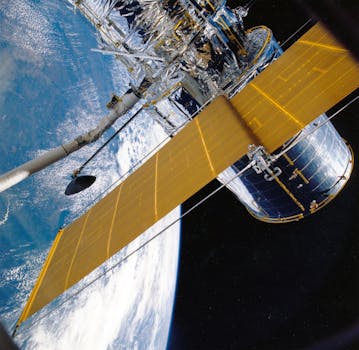Orbiting Innovations: Key Updates in Satellite Telecommunications Technology

Orbiting Innovations: Key Updates in Satellite Telecommunications Technology
Orbiting Innovations: Key Updates in Satellite Telecommunications Technology is a rapidly evolving field that has been transforming the way we communicate and access information. The latest advancements in satellite telecommunications technology are enabling faster, more reliable, and more efficient communication services, which are essential for various industries, including telecommunications, navigation, and remote sensing.
Introduction to Satellite Telecommunications
Satellite telecommunications technology involves the use of artificial satellites in orbit around the Earth to transmit and receive signals. These signals can be used for various purposes, including voice and data communication, internet connectivity, and television broadcasting. Satellite telecommunications technology has been in use for several decades, but recent advancements have improved its efficiency, reliability, and accessibility.
Key Updates in Satellite Telecommunications Technology
Several key updates have been made in satellite telecommunications technology in recent years. One of the most significant updates is the development of high-throughput satellites (HTS), which offer faster data speeds and greater capacity than traditional satellites. HTS use advanced technologies, such as spot beams and frequency reuse, to provide higher data rates and more efficient use of bandwidth.
Another key update is the introduction of low-Earth orbit (LEO) satellites, which operate at lower altitudes than traditional geostationary satellites. LEO satellites offer several advantages, including lower latency, higher data rates, and improved connectivity. Several companies, including SpaceX and OneWeb, are currently developing constellations of LEO satellites to provide global internet connectivity.
Advancements in Satellite Antenna Technology
Satellite antenna technology has also undergone significant advancements in recent years. One of the most notable developments is the introduction of phased array antennas, which use advanced beamforming techniques to steer and shape the beam. Phased array antennas offer several advantages, including higher gain, improved interference rejection, and increased flexibility.
Another key development is the introduction of flat panel antennas, which use advanced materials and designs to provide high-gain and low-profile antennas. Flat panel antennas are ideal for use in small satellites and other applications where size and weight are limited.
Applications of Satellite Telecommunications Technology
Satellite telecommunications technology has a wide range of applications, including telecommunications, navigation, and remote sensing. One of the most significant applications is the provision of internet connectivity to remote and underserved areas. Satellite telecommunications technology can provide high-speed internet connectivity to areas where terrestrial infrastructure is limited or non-existent.
Satellite telecommunications technology is also used for navigation, including the Global Positioning System (GPS) and other satellite-based navigation systems. These systems use satellites in medium Earth orbit to provide location information and timing signals to receivers on the ground.
Remote sensing is another key application of satellite telecommunications technology. Satellites in orbit around the Earth can collect data on various parameters, including temperature, humidity, and vegetation health. This data can be used for various purposes, including weather forecasting, climate monitoring, and crop management.



